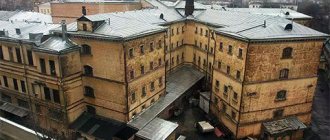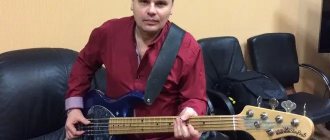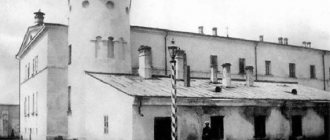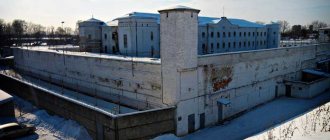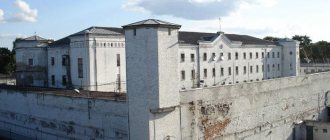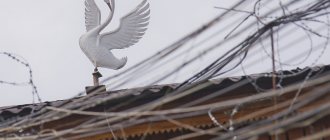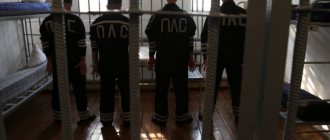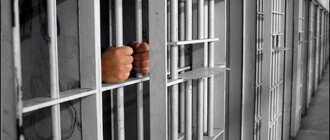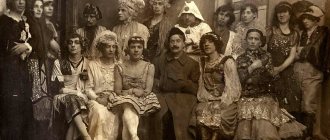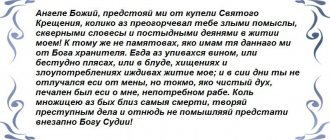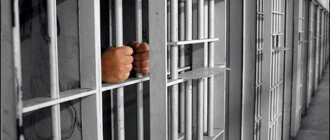Escape from Butyrka
Butyrka prison cannot boast of the absence of escapes. Throughout the history of its existence, people have escaped from it more than once. There is no exact information about the escapes of a hundred years ago; during the years of the USSR they were completely silent about this, but the following is known about the “runners” of recent decades:
1996
Natalya Sorokozherdeva studied at the Saratov Law University and worked part-time as a secretary. Obviously, the future lawyer was tired of such a boring life and, having abandoned her studies, went to the capital, where she was soon detained for robbery, selling currency and possessing weapons. For this she received five years in prison, appealed the verdict, and until the court’s decision, Butyrka prison became her home.
Maybe nothing would have happened if a woman similar to her had not been in the same cell with Natalya, who was soon to be released. Sorokozherdeva persuaded this person so that she, Natalya, would be released instead. And after some time the woman should have started to be indignant, why, they say, aren’t they releasing me?!
So they did. Natalya was not free for long - she was caught and Butyrka prison again became her home. Everything is clear with her, but how did her accomplice agree to such an adventure? As a result, the woman was accused of complicity in the escape and was given a new sentence (instead of release)!
2000
And again a substitution. A criminal from Georgia was awaiting a verdict on a serious crime. In the same cell as him was a man who was soon to be brought to court to hear his sentence (it was supposed to be a suspended sentence). The Georgian bandit managed to persuade the poor fellow to switch places with him, and instead of him he was taken to court, where he heard the verdict and was calmly released. The fraud was discovered five days later. Well, the prison officers and guards are working!
September 2001
B. Bezotechestvo, A. Kulikov, V. Zhelezoglo - three prisoners from the same cell, convicted of especially serious crimes, did not have the slightest desire to sit for many years in Butyrka. The cell had not been renovated for a long time, and the floor was in poor condition. The prisoners were able to use spoons to pick at the cement floor and dig a tunnel through which they climbed out. Kulikov and Zhelezoglo were detained three weeks later, the third fugitive (Bezotechestvo) was caught only almost two years later.
October 2001
Butyrka prison “sheltered” Ivan Vinogradov, convicted of a shootout in which a traffic police inspector was wounded. On October 1, 2001, Vinogradov managed to escape from the visiting room using the ID of an employee of the penitentiary system. It took a month to catch the fugitive. At first it was assumed that Vinogradov was helped by one of the pre-trial detention center employees, but the investigation showed that this was not the case.
March 2010
Belarusian Vitaly Ostrovsky, the champion of Belarus in parkour, who was also fond of mountaineering, was in a pre-trial detention center for committing numerous thefts. Excellent sports training helped him escape from Butyrka in a way that no one could have imagined.
Ostrovsky really did not want to be extradited to Belarus, and this, of course, would have happened, since he committed most of the crimes on the territory of this country. And the conditions in Belarusian prisons are much harsher than in Butyrka prison.
Prisoners were periodically taken to the bathhouse to wash themselves. It was Ostrovsky’s turn. He and another cellmate were taken to the “wash” only by one unarmed guard, who, moreover, did not handcuff them. During the escort, Ostrovsky pushed the guard away from him and ran. The warden wanted to rush after him, but did not dare to leave the second prisoner unattended.
In addition, for some reason the door from the building was open... Ostrovsky ran out of the building, quickly ran through the courtyard, jumped up to the fence and deftly jumped over it, clinging to the ledges. And the fence was five meters high!
He was caught two years later in Finland.
April 2010
Butyrka prison. Camera. 24-year-old Vasily Lokalev squeezed out the bars on the window, climbed onto the roof of the isolation ward, jumped down and was gone. True, he managed to walk free for less than a day.
The function is unchanged
Entering the Butyrka Prison Museum is like entering a prison. In the 1990s, everyone was allowed in, now only on applications from legal entities. First they issue a pass, you have to wait among other citizens, more often even female citizens, in order to enter into their hopeless conversations. "Seven years. And the lawyer says two. And seven." Then you go through three checkpoints, then along the parade ground you go to the prison yard. An interesting parade ground - with anti-ram hedgehogs, shrouded in Bruno's barbed spiral. Hedgehogs were placed around the perimeter for beauty. The yard is also interesting. There was a gallows here; General Vlasov was hanged in the courtyard on August 1, 1946. And 12 more people. And there is already a passage to the tower, where the museum is.
The tower is called Pugachevskaya, on the grounds that Emelyan Pugachev was imprisoned here before his execution. Actually, not here. Pugachev was executed in 1775, Catherine II ordered the construction of Butyrka Castle only in 1784. Pugachev was not there, but in the tower there is a Soviet execution room. The museum is on the fourth floor, but they were shot on the first floor. The room is the same size as the museum, only the walls and floor are tiled, easy to clean. There is now a warehouse for a prison store; no executions have been carried out here since 1991. But Lieutenant Colonel Alexander Vladimirovich Polkin, who took me around the museum, told me that the old-timers still remember how they were shot. Why, since 1991 there are still a lot of old-timers. They have an annual holiday there, Young Employee Day. Veterans come, remember, tell stories. They share their experience.
There are generally a lot of holidays there. When they took me there, they were preparing everywhere for the All-Russian Day of Detention Center Workers, which is November 1st. All jailers were ordered to come in a tunic with orders, whoever had one, and the bottom was ordinary. They also host the “Cup of Fallen Special Forces and Special Forces Soldiers.” I don’t even know how to imagine it. And the “Miss Federal Penitentiary Service” competition is held there. Nominations “Miss Tenderness”, “Miss Charm”, “Miss Femininity”. There is a large women's building in Butyrka. Employees compete in shooting, knowledge of internal regulations, and dancing. This place is very festive. Movies were filmed here, as well as “17 Moments of Spring” and “The Investigation is Conducted by Experts” too.
I went there with the film crew of the Kultura channel, they were filming a film about corporal punishment. “Please tell me about spanking,” asked Alexandra Polkina, a pretty employee of the channel, embarrassed. “They flogged her in the yard,” said the lieutenant colonel, looking at her with kind, understanding eyes. “They tied her to goats and flogged her.” “And now not?” - she hoped. “Not now,” he grinned sparingly, like a man. There, above the entrance to the museum, there is an inscription with a quote from Peter I: “Prison is a cursed craft, and for a sorrowful task, strong, kind and cheerful people are needed.” This is Lieutenant Colonel Polkin.
It's good when a woman has such a specific interest in corporal punishment. What should I ask?
They decided to build a museum here in 1971. They did the film, the exposition is completely Soviet. On top of the round room there is a frieze with scenes from the life of prisoners, so sprawling, there is life in a cell and hard labor. On one panel there is a signature: “Raf Aipetrimov.” I have never heard the name of such an artist. Below are stands with photographs. Part is about the history of the institution, part is for forensic experts. Photos of tattoos. Collections of iron objects swallowed by prisoners to get into the hospital. Spoon handles are swallowed more often. Then there are display cases with authentic items. Knives, sharpening, homemade devices for tattooing. Even lower, on the floor, there are pre-revolutionary shackles, chains, and collars. The modern part contains a collection of designs for tattoos. On fragments of sheets, in ballpoint pen, on some, dedicatory notes - “To the Tramp from the Poor Man.” Various products made by prisoners - sailboats, a model of a cruiser, maps. It seems that before the revolution, prisoners sat in shackles and handcuffs, and then they practiced art more. On the windows of the tower there are stained glass windows with Pugachev. In the center there is a pillar with a portrait of Felix Dzerzhinsky (he sat here from 1910 to 1917), an honor board with Butyrka bosses from the 1950s. It’s interesting that they somehow don’t stay for long. For some reason, since 1991, the boss of Butyrka has lived in his place for no more than three years.
Osip Mandelstam was thrown into this prison. Lydia Ginzburg, Varlam Shalamov. Here, in these cells. In Stalin's time, there were up to 20 thousand people in Butyrka, and Kazakov built for three thousand. 170 people were crammed into a cell with 27 seats. They managed one square meter per prisoner. Not that it’s worse than shackles, but it’s also not going to go away. And several thousand people were shot here, right here in the basement. At the Council of Bishops of the Russian Orthodox Church, 136 prisoners of the Butyrka prison were canonized and glorified as Russian new martyrs and confessors of the 20th century. But there is absolutely no material about all this in the exhibition. The Soviet era there is illustrated only by the idea of improving the character of a prisoner under the influence of being in prison. “Engineer N.I. Khrustalev, a former wrecker, became the chief engineer of Belomorstroy. In 1933 he was awarded the Order of the Red Banner of Labor.” “Engineer K. M. Zubrik, a former wrecker, became a talented engineer.” After all, he “became talented,” but was a simple pest. Very useful place.
And this is a stunning architectural monument. Matvey Kazakov, 1784, early neo-Gothic. And the preservation is amazing. Here is the second monument of the Cossack neo-Gothic style - the Petrovsky Travel Palace - which was completely rebuilt, but here nothing was rebuilt. Monument preservationists unanimously say that the best thing for a monument is when function is preserved. And here it remains the same, it was and is a prison. And the standard of living has practically not changed; whatever standards Kazakov had, they remain the same. Well, maybe some overcompaction happens, but this is no longer according to the norms. That is, in fact, the thing was made in the 18th century and has served like new ever since. In the famous “Instruction for deputies assembled to establish the laws of the Russian Empire,” Catherine II, among other things, proposed changing the rules of imprisonment and, in particular, abolishing pretrial imprisonment for crimes not related to direct violence against the individual (murder, etc.) . She explained her proposal by saying that being kept in our prisons is the same as torture, and if at trial it turns out that a person is innocent, it turns out that they were tortured in vain. She proposed it, but did not cancel it; the deputies advised against it. And this is how the prison was built and how it is used, only the bucket was replaced with a toilet, central heating was introduced and the number of prisoners in the cell was increased. And this is precisely a pre-trial detention center, that is, a pre-trial detention center.
A heavy passivity takes over after visiting this museum. Well, there were tsars, then Bolsheviks, then democrats, then vice versa. Under Nicholas, Vladimir Mayakovsky was imprisoned here, and under Stalin, Osip Mandelstam. It’s true that Mayakovsky was not shot, he later shot himself, and even if Mandelstam was shot, it was not here. “Of the interesting recent guests, I would like to mention Zhanna Aguzarova,” said Lieutenant Colonel Polkin. It seems like so many states have changed, but what about prison? Everyone needs prison.
So it's a very important museum. With just a few touches in a limited space it is possible to create a mood of prison humility. This is very important for a museum - to convey the very essence of the phenomenon being demonstrated. But what is the essence of prison? Is it tattoos or swallowed spoons? She is in dull despair before the inescapability of evil.
Novoslobodskaya street, 45
Butyrka Prison Museum
Museum in Butyrskaya prison
In 1971, a museum was opened in Butyrskaya prison, on the 3rd floor of the Pugachev Tower. Previously, only employees of the establishment could visit it, but now excursions are offered here. However, to get there, you will have to undergo strict control and inspection.
And now you find yourself in the oppressive atmosphere of the Pugachev Tower. You look around, but don’t see the entrance to the museum anywhere. It turns out that he is hiding behind a bookcase. Enter it, go down into the dungeon, pass by a mannequin in the form of a warden - and now you are in the museum.
Here you can see the whole history of Butyrka prison. Paintings depicting prison life; photos of former “guests”; things the prisoners made with their own hands while sitting in their cells - maps, models of sailing ships, sharpening tools, tools for tattooing. Particularly worth highlighting is the exhibition of things that prisoners swallowed in order to end up in a hospital ward from their cell. One cannot ignore the so-called aggravating objects (which make the prisoners’ existence more difficult): shackles and an iron spear, which did not allow the prisoner to sleep; A 25-kilogram “anti-escape” chair to which the prisoner was attached and he carried it everywhere.
In the museum you can also see things made by prisoners in the workshops.
Elena Karpukhina, gymnast
Interesting fact. The museum guide shows the Singer sewing machine, which the fashion designers kept in Butyrka sewed clothes on. They say that among them there were very talented and famous people, the things they sewed were even supplied to the Kremlin.
And in the Butyrka prison museum there is an exhibition dedicated to Elena Karpukhina, a multiple winner of world championships in rhythmic gymnastics.
Elena Karpukhina was born in 1951 in Butyrka (her mother was imprisoned here) and spent the first two years of her life here. At the age of 16, the girl became the world champion.
Elena Karpukhina donated all her medals and cups to the museum. She takes an active part in all events of the Butyrka prison, meets with prisoners, and is a member of the board of trustees.
How I wanted to go to prison, but didn't
Photo from the Internet.
It is impossible to get there from the street. Interest in the museum must be supported by documentary evidence. My attempts to penetrate the museum are worthy of a separate story, which will be discussed further.
Three years ago, I asked the RSP secretariat to give me a letter of recommendation for Petrovka 38 to the Museum of Forensic Science. Then everything worked out. I ended up at Petrovka (I can’t write about this by agreement). Later he asked me to write another letter addressed to Butyrka’s boss. This was compiled. Moreover, the RSP secretariat sent it by mail.
The letter contained my contacts. Accordingly, I waited for them to call me. A month passes, I understand that something is wrong here. I called the boss’s secretary in Butyrka. She replies that they did not receive any letter.
Next, the woman advises sending the letter by fax. I come to the RSP secretariat, they give me a letter. I start rushing around offices looking for a fax. Nowadays, such a technique is a rarity. And yet I find the fax. On the third or fifth attempt, they answer from the other end that the letter has arrived.
I am again waiting for an invitation without receiving an answer. I consult with a man named Andrey (changed), who worked in a similar service. He replies that he will try to help get into a similar museum in Kresty.
St. Petersburg Crosses is a slightly different topic. I am more attracted to the history of Butyrka and its inmates, and not to the conditions of detention. And yet I agree. I appear again in the RSP and declare that it’s not working out with Butyrka, I ask you to give me another letter to Kresty.
Here an incomprehensible silence begins, and then the secretariat announces to me that we will no longer use this practice of letters of recommendation. I ask this way and that - the answer is a clear no. The old Russian rule applies here - no matter what happens. RSP chose to keep a low profile and not take risks.
At this moment, one knowledgeable person explains to me as an amateur that such issues are resolved not by mail, but by feet. He advises that I go to Butyrka myself and explain the situation. I attach the legs to the hopelessly outdated letter and go to the reception.
Everyone has pleasant moments in life that they want to share with others, and there are also those that they don’t want to talk about. What I want to tell you about did not bring me joy. On the contrary, such places in some way take away energy. Still, I think it’s worth telling.
The head of Butyrka receives visitors once a week. In order to get to the reception, people keep a list that is posted near the door. At the appointed time, the boss (both times I ended up with a deputy) enters the office and begins the reception. He sits in the same room with a lawyer. The people, for the most part, are rushing here and there.
90% of walkers are women. They are divided into wives and mothers. The latter make up the absolute majority, many cry, some have hysterics. Women come to Moscow to get an appointment, and there is a huge queue. The issue cannot be resolved quickly. Mothers, most of whom are pensioners, huddle at night in corners and train stations. Looking at them, listening to their conversations, you scratch your own soul.
(I remember in the 90s I talked with an investigator from Matrosskots Tishina. Everyone was showing off then. Leather jackets were in fashion. In turn, the investigator told me: “I look at all this cronyism and it makes me laugh. All these people get caught bulls come to me, they begin to pawn each other. Mothers beg tearfully for them. Sometimes I myself feel sorry for them, even though I have to imprison them."
A lawyer can help you obtain permission to install a refrigerator or TV in your cell. His line is moving faster. The boss solves more complex issues, and therefore one visitor can hang out with him for an entire hour.
I was surprised to learn that the relatives did not bring the TV and refrigerator here themselves. Equipment can be ordered for delivery from the store.
Walkers with groceries are constantly scurrying through the hall where visitors are waiting their turn to be received. There is another hall nearby where transmissions are received. The weight limit rule applies here. I saw two Caucasians bring a large box with the freshest tomatoes and a whole bag of rolls and sausages. Then indignant voices were heard. The transfer was terminated. The guys managed to write something off to the sidekick, while they took a significant part of the food back.
Women of retirement age carry more modest transfers. Residents, like ordinary citizens, are divided into rich and poor.
The closer the time for the end of the reception approaches, the more the tension increases. The first time, realizing that I was running out of time, I left and signed up for the next week. The second time the situation was about the same. The only thing is that the list with the queue disappeared somewhere; those who came earlier wanted to start the queue from scratch. They were not allowed to do this; many of them had their old list photographed on their phones. In a word, everything here is like in the old Soviet times, or almost everything.
To whom is war, and to whom is mother - a proverb that is relevant for any time. A special segment of visitors are lawyers and all kinds of jurists. They are distinguished by their confident behavior, fancy iPhones, mandatory briefcases and expensive clothes.
Nimble as monkeys, these guys and girls scurry back and forth, waiting for a pass. They do not contact petitioners. The first and second, although they form a single river, at the same time remain completely different flows, in which different laws of physics and universal gravitation operate.
Straining my ears, I overheard the sleek lawyer explaining to his colleague:
“I tell him, I’ll try to bring it in, but I’m not sure... The most important thing, tell me, I didn’t see this, I was just standing next to it - you’ll go under a different article. What's the point, he waved them off anyway... So I'm telling you, it's unknown how things will turn out at the trial. No later, the entire amount must be taken at once...”
I was also surprised by the strong, athletic-looking guys. I thought, the guys, not embarrassed by anyone or anything, talking about something with the employees of the detention center, are solving their own issues. No, strong gangster-looking guys turned out to be investigators and interrogators. As they say, whoever you mess with, you'll gain from.
The second time I didn’t get an appointment again. There seemed to be a line, but it didn’t promise to reach me. One of the employees, seeing that I was not an ordinary person for this place, asked what I wanted from the boss? Having heard the answer, she explained that people go to the museum, but the head of Butyrka does not deal with such issues. Permission to visit is issued by the general.
It turns out I was hitting the wrong wall. My letter was formatted incorrectly. In this fuss they simply threw him aside, not considering it necessary to answer. Everything is logical, vanity reigns here, mixed with tearful requests. There is a ton of things to do, a ton of questions - they need to be resolved, but here I am with my nonsense...
The ensign radiated confidence that was passed on to me. Having looked at the address and reception hours, the next week I went to Narvskaya Street, where another pre-trial detention center is located. Having called the secretariat from the checkpoint, I outlined the essence of the issue and made an appointment with the general. Surprisingly, they issued a pass to me.
While I was hanging around at the checkpoint, an employee came out through the turntable and asked me if I was Egorov, who came to serve time after the verdict was passed? This is how you can easily get inside a pre-trial detention center without doing anything!!!…
By the appointed time, a small crowd had gathered, again consisting of women. After reading out the list, the guard let us into the territory one by one.
I was the last to be invited into the office. Next to the general sat a human rights activist who recorded citizens' appeals. The general himself, although a year younger than me, looked very respectable, which made me even a little nervous. After some time, he was supposed to hold a meeting with his employees, but he listened to me carefully, asking what exactly and what topic I wanted to know.
I replied that I was interested in Nestor Makhno. Where and how did he sit? Under what circumstances did he have his lung removed in Butyrka?
(This really interests me. In order to visit Makhno’s former capital Gulyaipole, I specially went to Ukraine. For those interested, I suggest you look at the stories:
Gulyaypole: literary (Walking through torment) and the present
Gulyai-Polye Museum of Local Lore)
The general promised to let me into the museum, asking me to write a new letter.
This is what is called the finish. The circle is closed! They can show me the prison museum if there is a letter, which the RSP no longer wants to give. I wrote and called them again, but to no avail.
One conclusion can be drawn from all this: in Russia, just like 100, just like 200 years ago, the basic rule of life is not to allow or let in, because - what if!
L.N. Tolstoy, while working on the novel “Resurrection,” in January 1899 visited the warden of Butyrka prison I.M. Vinogradov and asked about the details of prison life. In April 1899, he came to the transit prison to walk with the prisoners on the way to the Nikolaevsky (Leningrad) station, and then depicted this path in the novel.
In those distant years everything was simpler. In the present there are countries where you can go to prison. Moreover, schoolchildren are taken there on excursions so that they do not commit offenses in the future.
I remember in Soviet times there were signs everywhere: don’t walk on the lawns, don’t swim in the fountain. Accordingly, as a legacy of the dark past, paratroopers fought with riot police every year on Airborne Forces Day. The police were given the task of not letting the paratroopers into the fountain.
And suddenly one year they were allowed to swim. The guys climbed into the fountain in Gorky Park and began splashing around. Nothing terrible happened after that, the sky did not fall to the ground and all Moscow buildings survived.
The question arises: why did the police bother with legalized nonsense for so many years? And now everything is different with lawns: walk on the grass, choose a place, lie down where you want and relax.
I am a citizen of Russia, I have never been under investigation and have never been charged with any charges. Paying off my debt to my Motherland, I served in the army for two years. The question is, why can’t I get to the Butyrka prison museum? Moreover, I could write a short story that could theoretically stop someone from committing a crime.
According to Andrey, some time ago the Crosses could be visited by signing up for a tour. Then some important official arrived and made a remark - The pre-trial detention center has no right to take money. Excursions to the prison museum have been closed. Now you won’t get there, but everything is according to the law.
* * *
So, if I can’t get inside, no one forbids me to take a walk around the Butyrka prison.
Temple of Butyrka Prison
Temple in Butyrka Prison
As we wrote above, the Intercession Church was originally built in the center of Butyrka. But after the revolution of 1917, it suffered the fate of other churches in Russia - church utensils and silver were looted, workshops were first placed in the church building, and in 1922 it was completely closed.
In the thirties of the 20th century, the premises of the temple became a refuge for prisoners awaiting transport to Siberia. It was here, in particular, that Solzhenitsyn had to sit for some time. And according to him, the conditions in the cells of the temple were terrible, much worse than in the cells of the main buildings of Butyrka prison.
Also here were former high church ministers who were outlaws for the Soviet regime.
Decades later, the temple housed a prison hospital.
In the 90s of the last century the situation began to change. First, the priest began to come to the Butyrka Church, then in the former church he was given a corner where he began to conduct services. A few years later, a long renovation of the temple began, and in October 2004, on the day of the Intercession of the Most Holy Theotokos, the first service was held here.
Prayer room for Muslims
But it’s not only Christians who are in Butyrka prison. For example, usually a third of Butyrka prisoners are Muslims, so some time ago a prayer room was equipped for them in the Butyrka prison.
And for adherents of Judaism, a synagogue was opened in one of the cells.
For prisoners of any religion, getting to a holy place is not easy. First you need to write an application and wait a long time for your turn, since there are always a lot of people who want to pray, and the premises cannot accommodate a large number of worshipers. In addition, prison officials must compile lists of those wishing to pray so that people who should not meet, for example, former accomplices, do not meet in the temple.
According to the priests and the imam, the prisoners strive to get to the Church of the Intercession, the Muslim chapel and the synagogue, because they acutely feel their guilt and want to make amends for it both before people and before the Almighty.
Interesting facts about Butyrka prison
Mickey Rourke in Butyrka
Once upon a time, American actor Mickey Rourke found himself in Butyrka. He was not her prisoner, but simply visited on a tour. The prison authorities showed Rourke the cells, the museum, the temple and outbuildings. The actor talked with the prisoners and gave them his autograph, and the head of the colony gave him a prison uniform as a farewell gift. Why did Mickey Rourke need this? For some role in a movie. What was his impression? According to Mickey, conditions in Butyrka prison are much better than in American prisons.
On March 18, 1984, during a concert, singer Zhanna Aguzarova was detained and placed in Butyrka, where she spent some time. The reason for the arrest was that she had a passport in someone else’s name.
Some scenes of the cult Soviet series “Seventeen Moments of Spring” were filmed in Butyrka prison, in particular, the dungeons of the fascist Gestapo.
Group "Butyrka"
In 2001, the Russian musical group “Butyrka” was organized and exists to this day. Why did never-sat musicians with a clean biography choose such a name for their band? According to them, they were strongly impressed by the 2001 prison escapes, which we described above, which is why they called themselves the Butyrka group.
As we have already mentioned, many Muscovites do not like the fact that in the center of the capital, among residential buildings, there is the Butyrka prison. And many advocated for its transfer to another place. It looks like their dream will soon come true. Finally, a decision was made to move it to the Moscow region, but its building will not be demolished. We remind you that this is an architectural monument under state protection. Time will tell what they will do with it.
